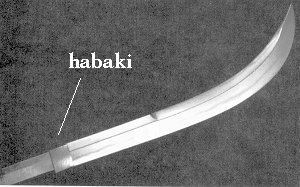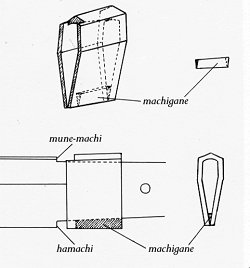Written by Sue Kent
SCNF
Crafting of the Saya & Kodogu
Introduction:
The habaki is a small metal "collar" which fits snugly over the blade at the point where the tang (nakago) meets the blade. It is usually made of copper, although gold, silver, and other metals are frequently added for decorative purposes. The habaki prevents the blade from being scratched as it slides in and out of the saya (scabbard) by allowing the blade to slide only on its burnished back surface. It also holds the blade firmly in place in the scabbard's opening (the koiguchi).

Naginata blade with habaki attached (Photo courtesy of Bugei Trading Company)
Throughout history, Japanese swords have utilized a habaki. Early habaki were usually made of iron or pot metal and welded onto the tang. Later, during the Heian period, habaki became a separate metal fitting and were made of copper. Copper is still the metal of choice today because it is soft and easily conforms to the shape of the blade. Also, since copper is softer than steel, it won't scratch the blade. In addition to copper, silver and "shakudo" (a copper-gold alloy) are occasionally used to construct habaki.
As with all of the sword arts of Japan, a lengthy apprenticeship is required before one can be considered accomplished in the art. In this case, an apprenticeship of approximately 5 years is required. The first thing an apprentice learns is the care of the tools used to make habaki. These tools consist primarily of different sized hammers and files. A propane torch is used to heat the habaki during annealing and soldering.
Jiganedori: Cutting the Blank
Most habaki are formed from a piece of copper which measures approximately 2 inches long and 1 inch wide. This is slightly larger than what is actually needed since some of the metal will be lost during the hammering and filing process. The thickness of the copper blank must be the same as the depth of the mune-machi; the small notch in the top surface of the blade at the point where the blade meets the tang. This thickness is typically about 1/8 inch. A hacksaw is used to cut the notch in the habaki which will allow it to fit snugly around the mune-machi.

Hizukuri: Forging
The silversmith repeatedly hammers the blank; forming it to the basic shape needed before the habaki can be fitted precisely to the blade. During forging, the habaki is hammered in such a manner as to be thicker at one end than the other (thicker at the end closest to the tang). This gives the habaki a slight wedge shape which will enable it to fit snugly into the scabbard. As with most metals, the hammering process results in a metallurgical condition known as "work hardening". The more it is hammered, the more brittle it becomes. In order to restore it to its original ductility, it must be annealed. This is done by heating the habaki with the propane torch, and then quenching it in water. NOTE: This effect is the EXACT OPPOSITE as seen during yaki-iri; the water quenching process used during the forging of the steel blade. Steel is the only metal which HARDENS when it is heated and then quenched. All other metals, such as copper, have their original properties restored by quenching.
Ouimage and Toshin-awase: Fitting Around the Blade
Before the fitting process begins, the blade is carefully wrapped in paper to protect its polished surface from being scratched. The rough habaki is then placed on the mune and hammered along its length until it conform exactly to the surface of the blade. Anything less will result in slippage and possible damage to the blade.
Hamachi-ire: Sealing the Habaki
A small wedge of copper, called the machigane, is placed inside the habaki in the area adjacent to the hamachi. The machigane is then soldered into place, where it provides maximum support for the blade.
Yasurigake: Filing
Now that the habaki is properly fitted to the blade, it is filed to fit the opening of the saya. Once this is accomplished, decorative grooves or other types of designs can be engraved in it, or decorative metal foils made of gold or other precious metals can be added. If decorative grooves are cut into the habaki, care must be taken to ensure that they are not too deep, otherwise they'll wear against the inner surface of the saya.
Naginata Construction
The Blade: Part 1
The Blade: Part 2
The Saya
Tsuba & Ishizuki
Crafting of the Saya & Kodogu
Introduction:
The habaki is a small metal "collar" which fits snugly over the blade at the point where the tang (nakago) meets the blade. It is usually made of copper, although gold, silver, and other metals are frequently added for decorative purposes. The habaki prevents the blade from being scratched as it slides in and out of the saya (scabbard) by allowing the blade to slide only on its burnished back surface. It also holds the blade firmly in place in the scabbard's opening (the koiguchi).

Naginata blade with habaki attached (Photo courtesy of Bugei Trading Company)
Throughout history, Japanese swords have utilized a habaki. Early habaki were usually made of iron or pot metal and welded onto the tang. Later, during the Heian period, habaki became a separate metal fitting and were made of copper. Copper is still the metal of choice today because it is soft and easily conforms to the shape of the blade. Also, since copper is softer than steel, it won't scratch the blade. In addition to copper, silver and "shakudo" (a copper-gold alloy) are occasionally used to construct habaki.
As with all of the sword arts of Japan, a lengthy apprenticeship is required before one can be considered accomplished in the art. In this case, an apprenticeship of approximately 5 years is required. The first thing an apprentice learns is the care of the tools used to make habaki. These tools consist primarily of different sized hammers and files. A propane torch is used to heat the habaki during annealing and soldering.
Jiganedori: Cutting the Blank
Most habaki are formed from a piece of copper which measures approximately 2 inches long and 1 inch wide. This is slightly larger than what is actually needed since some of the metal will be lost during the hammering and filing process. The thickness of the copper blank must be the same as the depth of the mune-machi; the small notch in the top surface of the blade at the point where the blade meets the tang. This thickness is typically about 1/8 inch. A hacksaw is used to cut the notch in the habaki which will allow it to fit snugly around the mune-machi.

Hizukuri: Forging
The silversmith repeatedly hammers the blank; forming it to the basic shape needed before the habaki can be fitted precisely to the blade. During forging, the habaki is hammered in such a manner as to be thicker at one end than the other (thicker at the end closest to the tang). This gives the habaki a slight wedge shape which will enable it to fit snugly into the scabbard. As with most metals, the hammering process results in a metallurgical condition known as "work hardening". The more it is hammered, the more brittle it becomes. In order to restore it to its original ductility, it must be annealed. This is done by heating the habaki with the propane torch, and then quenching it in water. NOTE: This effect is the EXACT OPPOSITE as seen during yaki-iri; the water quenching process used during the forging of the steel blade. Steel is the only metal which HARDENS when it is heated and then quenched. All other metals, such as copper, have their original properties restored by quenching.
Ouimage and Toshin-awase: Fitting Around the Blade
Before the fitting process begins, the blade is carefully wrapped in paper to protect its polished surface from being scratched. The rough habaki is then placed on the mune and hammered along its length until it conform exactly to the surface of the blade. Anything less will result in slippage and possible damage to the blade.
Hamachi-ire: Sealing the Habaki
A small wedge of copper, called the machigane, is placed inside the habaki in the area adjacent to the hamachi. The machigane is then soldered into place, where it provides maximum support for the blade.
Yasurigake: Filing
Now that the habaki is properly fitted to the blade, it is filed to fit the opening of the saya. Once this is accomplished, decorative grooves or other types of designs can be engraved in it, or decorative metal foils made of gold or other precious metals can be added. If decorative grooves are cut into the habaki, care must be taken to ensure that they are not too deep, otherwise they'll wear against the inner surface of the saya.
Naginata Construction
The Blade: Part 1
The Blade: Part 2
The Saya
Tsuba & Ishizuki